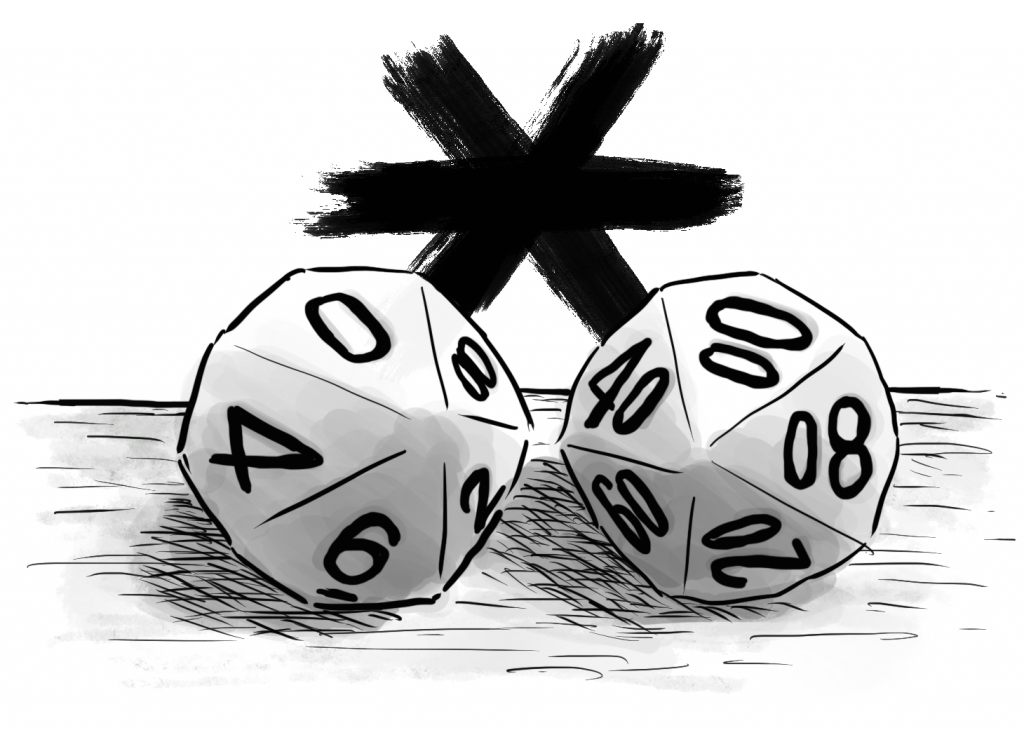
Runic Rants is an irregular series of thoughts, opinions, and experiments about RuneQuest.
In the previous parts of this Runic Rants series, we looked at all the situations that give you an experience check, and at miscellaneous stuff like “check hunting” and house rules. So now you have your experience checks and you need to do something about them. This is what some people call “rolling your ticks” (as I learned recently). More boring people might call it “making your experience rolls” or whatever. I used to be boring until a couple weeks ago.
Doing this usually happens in some kind of “downtime”. As written, the rules recommend to have one adventure per in-game season (RQG page 8). This is because it’s assumed that the adventurers are busy with their various responsibilities for the rest of the season: cult duties, family duties, worshiping, farming, patrolling, training, research, meditation, and so on. So with that model, you “roll your ticks” after every adventure. Other people play it differently, however, but we’ll address that shortly.
Fifty to Hero
So how many downtimes (a.k.a. “tick rolling” sessions) does it take to raise an ability? Let’s bust out some graphs! Hopefully my math is correct. Come yell at me if it isn’t and I’ll fix it.
Below is a graph that shows ability improvement starting from 50%, and POW improvement starting from 12. In both cases, the red line is the median of one thousand runs, going through 100 downtimes (on the horizontal axis). The adventurer’s score is obviously on the vertical axis. The reason I’m counting the number of “downtimes” and not “seasons” here will become apparent in the second half of the article.
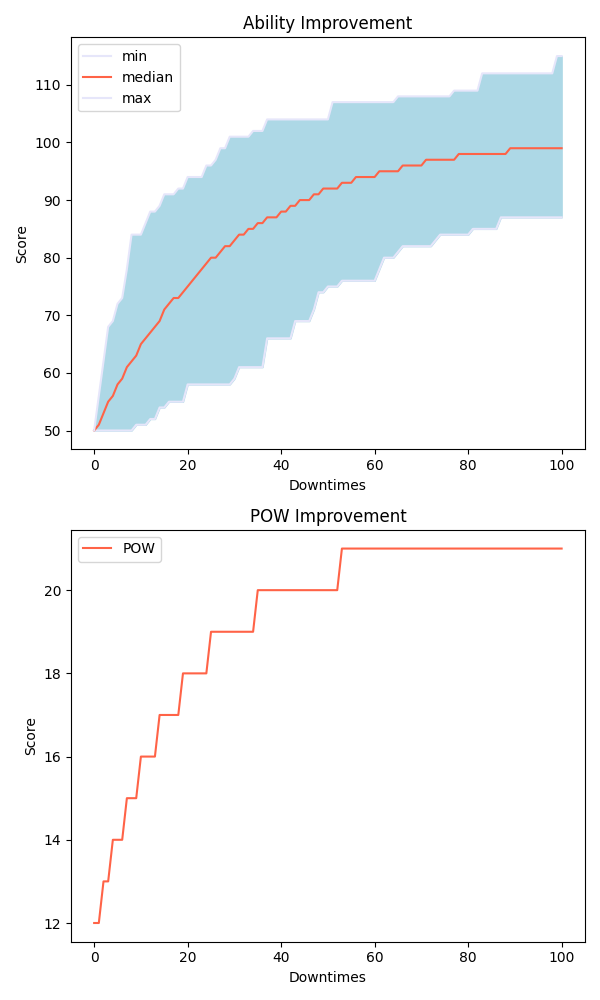
A good way to interpret these graphs is to figure out how long it might take to get to Rune Priest or Rune Lord level. You usually need:
- A few skills or Passions at 90%.
- POW or CHA at 18.
Some of the required skills and Passions might be pretty high from the start, but it’s possible that at least one or two of them are at 60% or less, especially if the player didn’t think too much about their future when creating the character. So on average it will take around 40 of these downtimes to get there, assuming you get an experience check every time. This should be easy thanks to the easily-missed (and previously mentioned) rule in RQG p416 that grants every adventurer up to four experience checks in occupational and cult skills.
POW goes faster, as it takes only around 25 downtimes to raise it from a lowly 12 to the required 18, but of course this will be significantly slowed down by POW sacrifices such as those to gain new Rune Magic. There’s no easy way to figure out how long it will take to reach POW 18 in practice, but we can see that the player can adjust their POW sacrifices as needed when the other requirements are closing in.
CHA is improved with training, which takes 2 seasons in game. With a 1D3-1 roll, it averages around +1 point every 2 seasons, so there’s no need for a graph. If the adventurer is dedicated (i.e. they train every season!), they can go from 12 to 18 in 12 seasons minimum. Probably even slightly faster if they get CHA bonuses from cool gear and reputable acts. Even if we were to double that time, CHA increase would still not be the blocking factor.
Training Extras
If you carefully read the text for the ability Training and Research rules (RQG p416), you might realize that you can train or research an ability that you have already increased through last adventure’s experience. This is because Training and Research don’t use the experience check, they are their own thing, handled differently. If you don’t believe me, see the Well of Daliath Q&A.
While Training and Research are very useful for increasing skills that don’t have checkboxes (which is very relevant to, say, Lhankor Mhy sages), they have the downside that, for those skills who do have a checkbox, they stop working once that skill reaches 75%. Still, that can come in handy. The graph below shows the same improvement curve starting at 50%, but with the adventurer going through a handful of training in the early part of the curve:

You can see the curve is much steeper until the score reaches 75%, and the ability now reaches 90% in about 30 downtimes, compared to about 40. So this makes a little bit of difference.
Since I mentioned Lhankor Mhy sages, those have requirements for skills that don’t have a checkbox, so those adventurers have to train or research to improve. Research is super slow, but training has the benefit of not having the diminishing returns of experience rolls. This lets an adventurer become weirdly forever better for as long as they can find a teacher that has a better score than them! By training every downtime, which yields +2.5% on average, they can raise a 50% ability to 90% in about 16 downtimes. This might be spread among two skills, though, in which case the sage’s free time starts to be torn between many different obligations, and reaching 90% can take more than twice that time.
Adventurer to Hero
Things are obviously better if you start with higher abilities, and RQG definitely lets players make very capable adventurers compared to previous editions. This also includes having positive skill category modifiers, which helps with experience rolls. In fact, getting positive skill category modifiers becomes more likely with time because CHA and POW (which players need to increase to reach Rune Level) often count towards them!
For instance, a +10% skill category modifier helps a bit, lowering the ~40 downtimes to slightly over 30 downtimes to go from 50% to 90%:
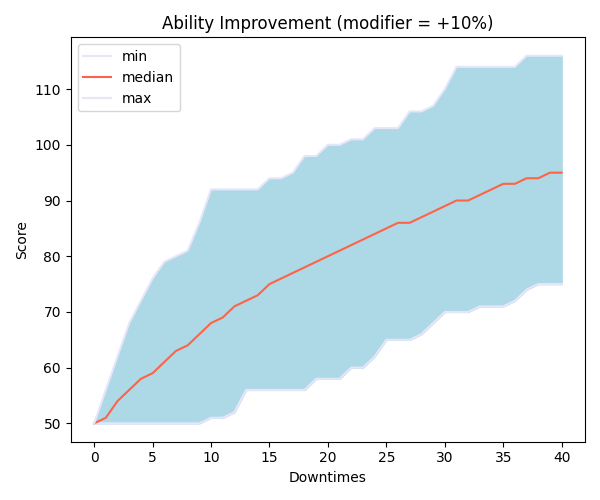
Below is the same graph (+10% skill category modifier) but starting from a 65% ability, and POW 15:

Now a competent adventurer can reach some of these Rune Level requirements in less than 25 downtimes. And if you were wondering about our Lhankor Mhy sage, stuck with skills without checkboxes, starting from 65% lets them reach 90% in only 10 downtimes, so they’re pretty good on that front too.
Want to throw in a handful of training sessions in the adventurer’s early years in addition to all of the above? Here it is:
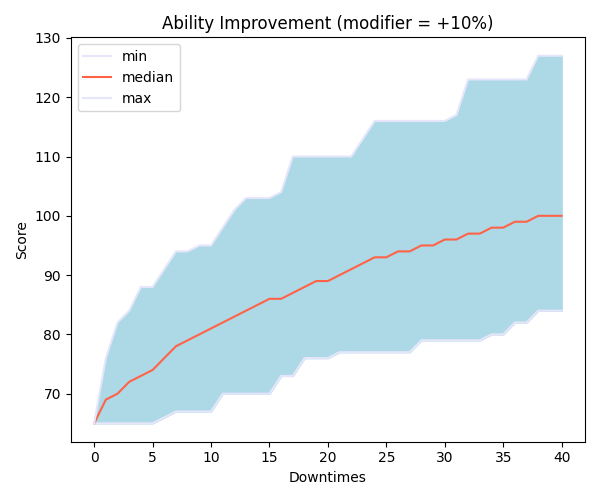
Yay, we’ve gotten down to 20 downtimes! Do you have tips to optimize it further? Besides cheating on your dice rolls to get into the higher part of the blue area that gets to 90% in, like, 5 downtimes? Send your suggestions!
Ok, we stared at enough graphs now to make this website look pompous and academic (we are the God Learners after all). Also my brain has started to shut down. I think we can basically sum up that it will probably take between 20 and 40 “downtimes” to get to Rune Level? Let’s go with that until someone finds an error.
Now don’t get me wrong: the goal of these graphs isn’t about minmaxing characters: it’s about managing expectations, and figuring out when, and how often, to insert these “downtimes” (‘tick rolling” sessions) in a campaign. And this leads us to…
Downtime Frequency
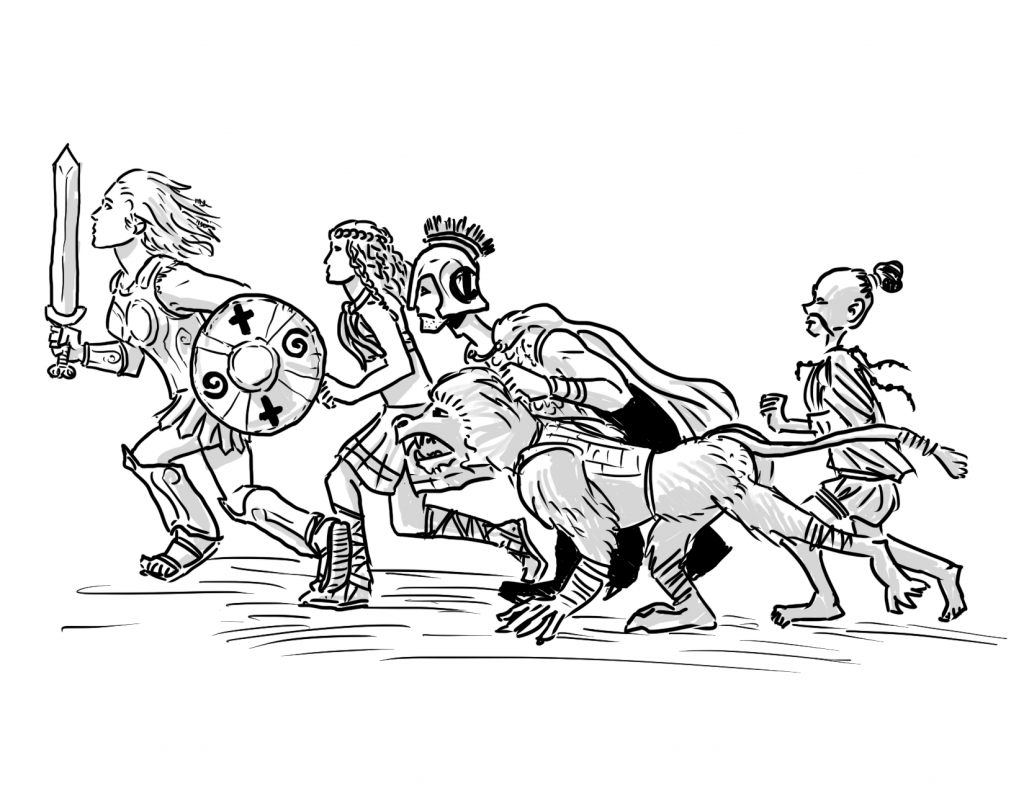
Seasonal Play
If we follow the rulebook’s advice of seasonal adventuring, we basically get one downtime after every scenario. Assuming an average of three sessions to complete an adventure (that’s pretty fast in my book but let’s be optimistic), playing bi-weekly, that’s about 8 adventures every year.
If we boil down all those graphs I went through the trouble of making to “it takes between 20 and 40 downtimes to get to Rune Level“, it corresponds to between 2.5 and 5 years of non-stop campaign play to get that in-game cult promotion. It seems important to know that when you make a character, if Rune Levels are important to you!
Also worth noting with seasonal play: after 30 adventures, you will have advanced the in-game timeline by about 6 years. So if your players wanted to be Rune Priests in the time of Argrath’s rise, you’ll need to make some adjustments…
Of course, you’ll have to adjust all these estimates based on how often your group plays, how fast they go through adventures, and so on. If you play weekly instead of bi-weekly, everything will go faster. My point here is that both the gamemaster and the players need to have the correct expectations. Not everybody can commit to a 3+ years game, so if they’ve read about these cool powers you get when you become Rune Lord, they might become disappointed if that feels out of reach.
Freeform Play
I suspect that many campaigns ignore the seasonal adventuring framework offered by the rulebook, and instead just advance time as necessary. The Chaosium White Bull campaign is one such game after all!
This is particularly suited to campaigns where the adventurers are mercenaries in a warband, soldiers in a military unit, merchants doing lots of traveling for trade, treasure hunters living near the Big Rubble, or the good old party of “murder tourists”. In these campaigns, downtimes and other fast-forwards occur whenever the players say that they are settling down for a bit.
Now, “rolling the ticks” doesn’t really need to happen during an actual downtime. They could happen between two adventures that occur just a couple days apart. But in freeform play, such as a sandbox game, it’s sometimes unclear where one adventure ends and another one starts… it’s usually all non-stop drama and action and burning down villages. So based on the seasonal play’s estimates, I’d say that the gamemaster should still have players “roll their ticks” at least every handful of sessions, whenever the opportunity arises (camping for a night, spending a day shopping around, etc). In this model, “rolling the ticks” will often happen independently from the rest of the “Between Adventures” chapter stuff: training, research, holy day worship, and so on, happen only when the players actually do it in game.
Speeding Things Up
Even with seasonal play, the gamemaster can sprinkle extra “tick rolling” sessions during long adventures to keep the character progression going. Whether this only involves skills, or also Runes, Passions, and/or POW is up to the gamemaster.
Just as with the “Freeform Play” model above, these extra experience rolls can happen, for example, during a bit of travel between the different parts of an adventure, after an investigation phase that lasted a few days in-game, or simply after what feels like the end of a narrative arc inside that adventure. If it feels like the adventurers could have a bit of spare time to reflect on their recent actions and learn from them, it’s probably a good time to some some experience rolls if that hasn’t happened recently.

So after all this number crunching, I think you’ll want to put some thought in your character’s abilities at creation if you’re eyeing a Rune Lord position in your future. For instance, get those five cult skills and POW or CHA as high as possible from the beginning, otherwise it will take much longer to reach 90% and 18. I know I said this wasn’t about minmaxing, but if you don’t at least pay attention to a handful of abilities, it might lead to disappointment later. Requirements for Rune Priest are a lot easier to reach, possibly on purpose because those characters tend to be more diversified than Rune Lords, but watch out for skills with no check box.
Also, there’s no shame in rolling for experience more often than not, such as once or twice in the middle of a big adventure. The worst that can happen is that the adventurers make Rune Level faster and the players have more fun earlier! And by “fun” I mean of course “more troubles, more responsibilities, and more deadly threats“. That’s the definition of fun, right?
If you have any comment about this Runic Rant, or some ideas for a future installment, please send them to us!


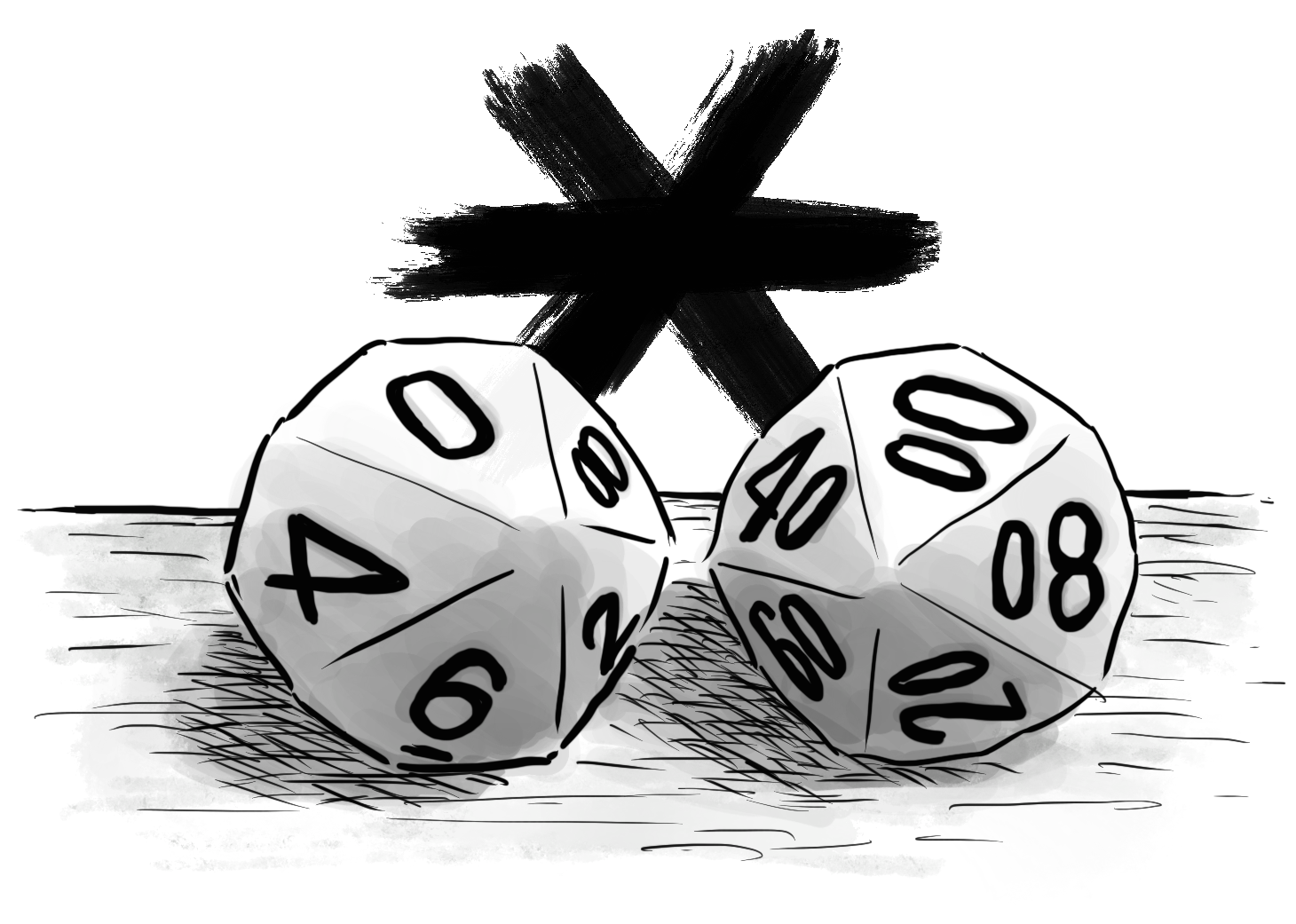
One comment on “Runic Rants: Experience Checks (Part 3)”